Stellar Financials for Nova Entertainment
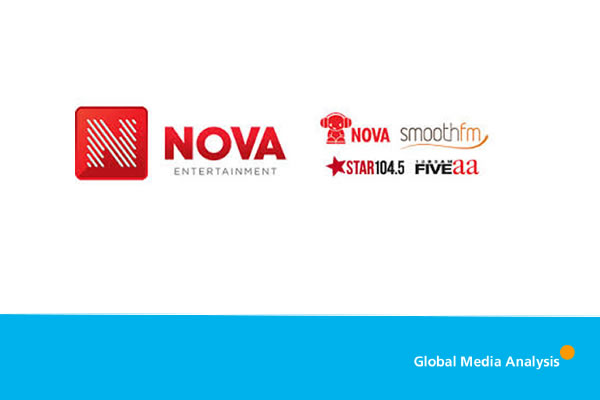
Lachlan Murdoch’s Nova Entertainment radio group recorded a stellar set of financial statistics during calendar 2015. Recently released financial accounts reveal that the metropolitan broadcaster realised a 39.5% jump in adjusted operating profits last year as a result of an impressive 13.1% increase in advertising revenues significantly outpacing both a 5.6% rise in adjusted operating expenses and only a modest 1.3% increase in total group listener numbers.
Last year’s exceptional earnings improvement enabled Nova, for the first time, to become metro radio’s second most profitable group, as measured by both adjusted earnings before interest tax and depreciation (EBITDA) of $62 million and adjusted EBITDA profit margins of 33.0%, displacing its long-time arch-rival Austereo, who up until 2013 had been the industry’s perennial top profit performer.
Nova’s impressive increase in advertising revenues to $187 million was substantially better than the 5% rise in total metro radio advertising revenues over the same 12 month period and it represented the best revenue growth performance on a like-for-like basis of any metro radio group last calendar year.
Much of Nova’s above average revenue increase in 2015 is believed to have been the result of the group’s successful monetisation of both the ratings surges at its two smooth fm branded stations in Sydney and Melbourne, which over the past three years have increased their combined audiences by two-thirds, and also the continuing popularity of the group’s flagship five station NOVA branded network, which in CY 2015 retained its position as the #1 commercial metro radio network as measured by total listeners.
Perhaps as a precursor to a possible future sale or merger, a corporate restructuring occurred within the Nova Entertainment group of companies on 1 January 2015 when the operating assets of the group were transferred in to a new corporate entity at a price which appeared to represent an enterprise value of $420 million.
That valuation may reflect the owner’s starting point in any negotiations to either sell or merge the group sometime in the near future as part of a much-anticipated consolidation within the local media industry.
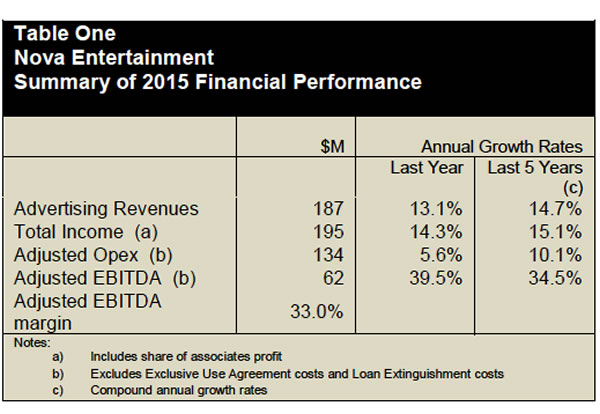
Outstanding Financial Performance in 2015
Nova Entertainment generated an outstanding financial performance during calendar 2015. The metropolitan radio broadcaster realised a 39.5% leap in adjusted operating profits last year as a result of an impressive 13.1% increase in advertising revenues significantly outpacing a lesser 5.6% rise in adjusted operating expenses, as shown in Table One.
Nova’s above-average increase in advertising revenues to $187 million was substantially better than the 5% rise in total metro radio advertising revenues over the same period and it represented the best revenue growth performance on a like-for-like basis of any metro radio group last calendar year.
Much of Nova’s sizeable revenue increase in 2015 is believed to have been the result of the group’s successful monetisation of both the ratings surges at its two smooth fm branded stations in Sydney and Melbourne, which over the past three years have grown their combined audiences by two-thirds, and also the continuing popularity of the group’s flagship five station NOVA branded network, which in CY 2015 retained its position as the #1 commercial metro radio network, as measured by total listeners, despite a modest 3.3% decline in average listener numbers at the network during the year1.
Last year’s exceptional earnings improvement enabled Nova, for the first time, to become metro radio’s second most profitable group, as measured by both adjusted earnings before interest tax and depreciation (EBITDA) of $62 million and adjusted EBITDA profit margins of 33.0%, thereby displacing its long-time arch-rival Austereo, who up until 2013 had been the industry’s perennial top profit performer, as shown in Chart Five below.
During the year, Nova managed to limit increases in its adjusted operating expenses to only 5.6%, which gave it a cost structure almost identical to that of the Australian Radio Network (ARN), but more than 23% lower than that of Austereo, as shown in Chart Four.
Critical to its cost containment success was Nova’s ability to limit employee benefit expenses, which accounted for just over half of all adjusted operating costs in the year, to a modest 4.9% rise. On the other hand, production costs and advertising expenses rose by 16.0% and 14.5% respectively, probably reflecting the intense and on-going competition between the three major FM broadcasting groups for both listeners and advertisers.
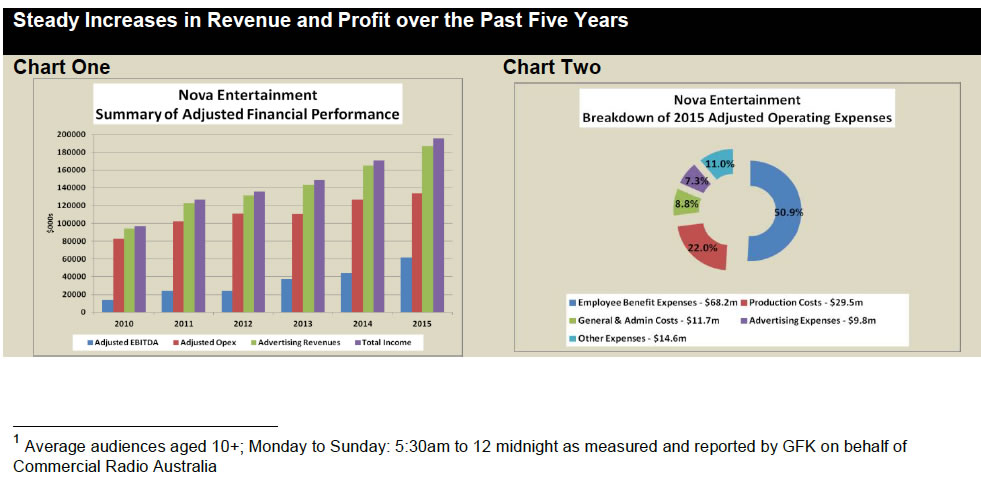
Continuing Financial Improvement since 2011
Nova Entertainment’s strong financial result last year represented a continuation of above-average financial performance over the past five years, as shown in both Table One and Chart One.
Together with ARN, Nova has steadily improved its ratings and financial position over the past half decade at the expense of Austereo, which no longer enjoys the dominant position which had held for more than two decades, as shown on Charts Three, Four, Five and Six.
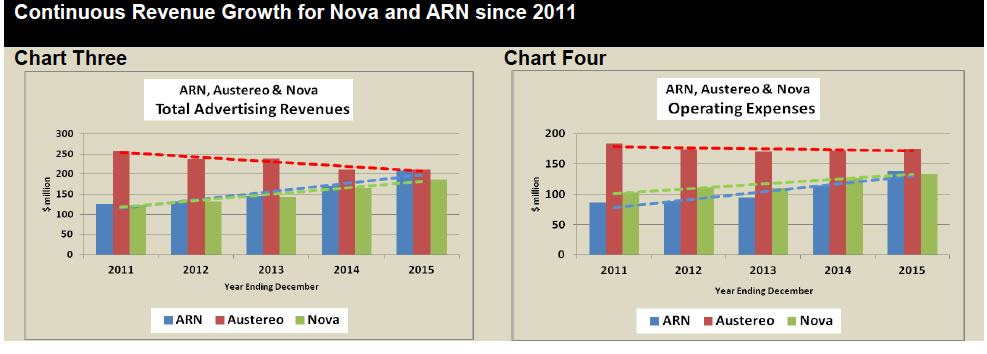
As at the end of CY 2015 the three commercial FM radio groups were arguably on a broadly equal footing in terms of future financial potential with each having certain unique points of differentiation and opportunity going forward.
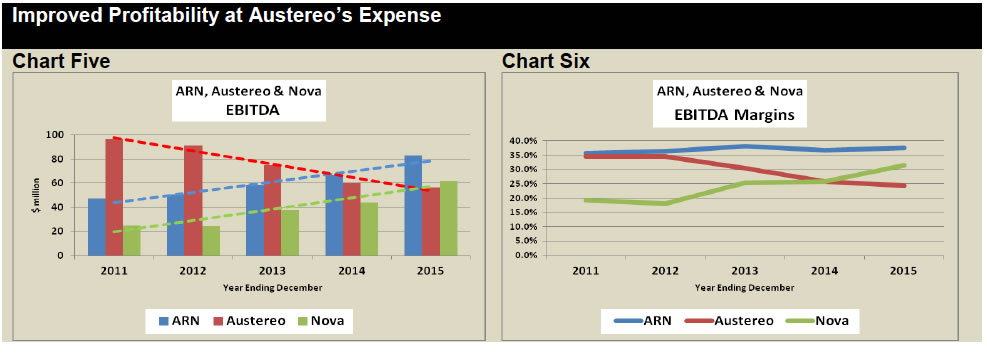
Adjusted versus Reported Operating Expenses and EBITDA
In order to facilitate an as accurate as possible like-for-like financial comparison between the three commercial FM radio groups, Global Media Analysis (GMA) has used its best endeavours to adjust, where necessary, Nova’s reported financial results to bring them in to line with those of ARN and Austereo.
Whereas the radio operations of ARN and Austereo are each owned by pubic companies whose shares are listed on the Australian Securities Exchange and whose subsidiary operations are therefore subject to certain statutory financial reporting requirements imposed on their respective parent companies, the ultimate owner of Nova Entertainment is a private corporate entity, which in certain instances may be subject to financial reporting requirements which differ from those of Nova’s two major competitors.
GMA made two major adjustments to Nova’s reported financial results for CY 2015 and earlier years in an attempt to put them on a more comparable basis to the results reported for ARN and Austereo by their respective listed parent companies.
First, in its calculation of Nova’s operating expenses and EBITDA, GMA excluded a sizeable and annually recurring exclusive use agreement expense which totalled $14.9 million in 2015 and which GMA assumed would not have been incurred had Nova had an ownership structure more comparable to those of ARN and Austereo.
Second, GMA excluded a $69.0 million loan extinguishment expense which first appeared in 2015 and which GMA assumed was a once-off and non-operational item which related to the corporate restructuring within the Nova Entertainment group of companies which occurred on 1 January 2015.
It should also be noted that prior to 2014 the Nova Entertainment group of companies had a 30 September balance date rather than the current 31 December one.
Nova’s Implied Valuation of $420 Million Plus
Perhaps as a precursor to a possible future sale or merger, a corporate restructuring occurred within the Nova Entertainment group of companies on 1 January 2015 when the operating assets of the group were transferred in to a new corporate entity at a price which appeared to represent an enterprise value (comprising equity plus external debt) of $420 million.
That valuation may reflect the owner’s starting point in any negotiations to either sell or merge the Nova group at some time in the near future as part of a much-anticipated consolidation within the local media industry.


